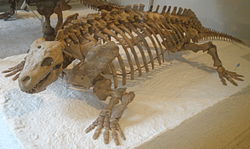Diadectidae
| Diadectidae Temporal range: Late Carboniferous – Late Permian, 305–256 Ma (possible Early Carboniferous occurrence) |
|
|---|---|
 |
|
| Skeleton of Diadectes sideropelicus in the American Museum of Natural History | |
| Scientific classification | |
| Kingdom: | Animalia |
| Phylum: | Chordata |
| Order: | †Diadectomorpha |
| Family: |
†Diadectidae Cope 1880 |
| Subgroups | |
Diadectidae is an extinct family of early tetrapods that lived in what is now North America and Europe during the Late Carboniferous and Early Permian, and in Asia during the Late Permian. They were the first herbivorous tetrapods, and also the first fully terrestrial animals to attain large sizes. Footprints indicate that diadectids walked with an erect posture. They were the first to exploit plant material in terrestrial food chains, making their appearance an important stage in both vertebrate evolution and the development of terrestrial ecosystems.
The best known and largest representative of the family is Diadectes, a heavily built animal that attained a maximum length of several metres. Several other genera and various fragmentary fossil remains are also known. Although well known genera like Diadectes first appear in the Late Pennsylvanian, fragmentary remains of possible diadectids are known from much earlier deposits, including a piece of lower jaw found in Mississippian strata from Tennessee.
Diadectids have large bodies with relatively short limbs. The rib cage is barrel-shaped to accommodate a large digestive tract necessary for the digestion of cellulose in plants. The skulls of diadectids are wide and deep with blunt snouts. The internal nares (holes for the nostrils) are also short.Paleontologist E.C. Case compared diadectids to turtles in 1907, noting their large pectoral girdles, short, strong limbs, and robust skulls. Case described them as "lowly, sluggish, inoffensive herbivorous reptiles, clad in an armor of plate to protect them from the fiercely carnivorous pelycosaurs."
...
Wikipedia
